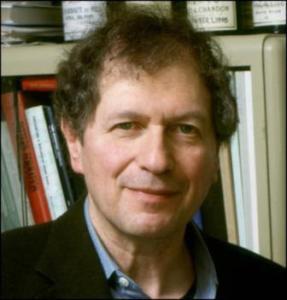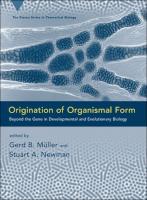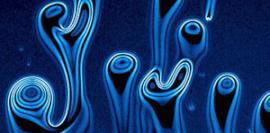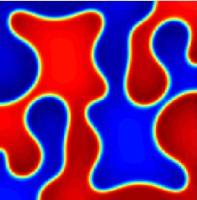Stuart Newman, The New Master Of Evolution?
Stuart Newman, The New Master Of Evolution?
Media First Peek at a New Theory of
Evolution
By Suzan Mazur

"A molecule of water does not form itself into waves and vortices. However, a mass consisting of trillions of water molecules does. You don't need new substances. It's just a matter of changing the scale and bringing new physical processes into play.
So if you have cells with genes that evolved for single-cell functions, and you put the cells together into clusters, then those clusters of cells have physical properties -- including self-organizing properties – that individual cells never had. And then those cell clusters can make 40 or 50 different kinds of forms very rapidly by virtue of the physics mobilized by the existing gene products in the changed scale. They don’t need a lot of genetic changes to go from one form to another. And the forms produced in this way can become locked in later by natural selection.” -- Stuart Newman
Earlier stories in this
series:
- Stuart Newman's "High Tea"
- Theory of Form to Evolution Center Stage
- Altenberg! The Woodstock of Evolution?
- "Altenberg 16" Evolution Summit
- Richard Dawkins Renounces Darwinism As Religion
On his recent PBS television show One On One, John McLaughlin quizzed two religion authors about whether the idea of the Virgin birth in the oral accounts of the Bible had a reference in biology, with someone mentioning parthenogenesis – asexual reproduction. But could those early storytellers have actually been feeling their way around the idea of orthogenesis , i.e., spontaneous birth, where life has the innate ability to move linearly?
The idea of orthogenesis was particularly popular with 19th century scientists, such as Ernst Haeckel and Jean-Baptiste Lamarck. Darwinian politics, however, coupled with fossil evidence showing non-linear patterns, led to an abandonment of the theory.
But orthogenesis has recently regained credibility and the puzzle's possibly solved as to why that fossil trail is actually linear. Paleontologists Niles Eldredge and Steve Gould suggested in their pivotal paper on punctuated equilibrium , for instance, that there was a deficiency of transitional forms.
Further scientific investigation has revealed why, and now our nearly 150-year old evolutionary synthesis -- which has never had a coherent theory of form -- is about to get one.
It was thrilling and somewhat humbling to read developmental biologist Stuart Newman’s hypothesis of the evolutionary triumph of life as it self-organized half a billion years ago, using what he calls toolkit genes from single-celled highly plastic organisms to make a balletic leap into multicelluarity at the time of the Cambrian explosion when virtually all of today’s modern animal forms (35 phyla) first appeared, as evidenced in the fossil rock.
These toolkit genes, some of which act to mobilize basic physical forces and processes, thereby becoming what Newman calls DPMs (dynamical patterning modules) -- along with others, the DTFs (developmental transcription factors) -- performed an almost hallucinatory dance on the page as I read through his paper about a patterning language calling up certain physical processes to enable multicellular animals, i.e., metazoa about a millimeter in size to body-build – cavities, layers of tissue, segments, extremities, primitive hearts and even eyes.
And while the DPMs got the DTFs to arrange the matter of cell types and region functions – Newman says it was the DPMs that really provided most of the pizzazz.
Interestingly, Newman says this part of evolutionary history turns the Darwinian theory upside down in the sense that natural selection is not central.
Stuart Newman will present his paper, "Dynamical Patterning Modules: a "pattern language" for development and evolution of multicellular form", co-authored by Ramray Bhat, Newman's graduate student from the University of Calcutta, at the Altenberg "Extended Evolutionary Synthesis" symposium in July. Before that, however, the Newman/Bhat paper will debut in two publications – the International Journal of Developmental Biology and Physical Biology. Newman says it represents a synthesis of twenty years of work.
Stuart A. Newman is currently Professor of Cell Biology and Anatomy at New York Medical College in Vallhala, New York where he teaches and directs a research lab.
He has collaborated with University of Vienna theoretical biologist Gerd Müller, University of Missouri biological physicist Gabor Forgacs as well as Ramray Bhat, on aspects of his DPM theory. He has also co-authored the textbook Biological Physics of the Developing Embryo (Cambridge University Press) with Gabor Forgacs, and with Gerd Müller co-edited Origination of Organismal Form: Beyond the Gene in Developmental and Evolutionary Biology (MIT Press), a volume about the origination of body form during Ediacaran and early Cambrian periods, also contributing a few chapters to it.


Newman’s A.B. degree is from Columbia University and his Ph.D. in chemical physics from the University of Chicago where he also did post doctoral studies in theoretical biology, as well as at the School of Biological Sciences, University of Sussex. Newman’s been a visiting professor at Pasteur Institute, Paris; Commissariat a l’Energie Atomique-Saclay and the Indian Institute of Science, Bangalore.
But Stuart Newman's also a public intellectual. Through the years he has commented on social and cultural issues affecting science. He chose not to stand on the sidelines regarding the ethical issues surrounding human genetic and bioengineering, for instance.
In 1997 along with Jeremy Rifkin, then president of the Foundation on Economic Trends, Newman attempted to patent a part human, part animal chimera to highlight the dangers of the commercialization and industrialization of organisms, which he fears will ultimately include humans.
In 2002 he testified before
the US Senate saying:
“Since my student days I have also been concerned with the uses to which scientific research is put. Having become convinced that scientists, who are beneficiaries of public resources [Newman has been the recipient of NSF and NIH grants for 30 years], have a deep responsibility to anticipate what lies down the road in their own fields and to serve as a resource for the public on the complex issues around applications of scientific research, I joined with other scientists, social scientists, women’s rights advocates and environmentalists, to found the Council for Responsible Genetics in the late 1970s.”
Newman has
also weighed in on politics’ impact on science in
Capitalism and Socialism, noting how political interference
can indeed warp research and deprive society of its
benefits. Newman wrote recently in “Evolution: The
Publics’ Problem, and the Scientists’” appearing in
Capitalism, Nature, Socialism.
“The Soviet doctrine of Lysenkoism represented by ideological distortion of evolutionary biology that may be thought of as generic to top-down socialism. . .the genetic determinist ideology that it both rejected and gave life to. . .comports well with the worldview of advanced capitalism.”
But getting back to Stuart Newman’s theory of evolution – what exactly did the DPMs (dynamical patterning modules) -- I count eleven -- look like singly? And moving in combination?
It seems that if these DPMs were physical-genetic modules, as Newman says in the paper, there ought to be a way to visualize them.
Did some appear as kind of wobbly electric neon discharges?

And others maybe resemble the old Camel smoke ring that once wafted through Times Square?
Newman does provide a schematic drawing at the end of the paper showing the effects of various DPMs acting singly and in combination. And there is a table listing the DPMs with the molecule each is linked to, its physical principles and its role in evolution-development.
He also says what DPMs were made of. They were gene products (proteins) but also networks of physical processes that shaped and patterned organisms using adhesion, polarization, viscoelasticity, etc. DPM elements also combined with one another to make oscillations and segmentation, as well as morphogens from secreted multicellular molecules.
The morphogens then traveled through the organism to create organismal forms. Newman says the survival of cell types later became a matter for selection.
There were also certain signaling pathways, like the Notch pathway, he says, that factored in.

Neural cells being activated by Notch signaling
Notch was established several billion years ago before multicelluarity occurred, as was the Wnt pathway , for example. Wnt in conjunction with the Frizzled family receptors of signals, made cells polarize.
Newman explains how spots and patterns were generated by morphogens. Lateral-acting inhibitors and reaction-diffusion systems

came into play. He says skeletal elements, bones, feathers and hair were created this way.
He also indicates that while some DTFs (developmental transcription factors) did exist in single-celled organisms for the purpose of cell contractility and light sensitivity, other DTFs – those participating in segmentation and tissue identity – did not exist in single-celled organisms. And he notes that combinations of DPMs and DTFs enabled segmentation, skeletogenesis, eyes to form and heart-like structures to develop.
Stuart Newman concludes that it was the multicellular state that led to the appearance of developmental mechanisms, and that transcription factors in regulating cell fates did not play a starring role in the patterning language at the time of the Cambrian explosion.
He says he's not comfortable with the title "The New Charles Darwin", though. Well, how about "The New Master of Evolution"?
 Suzan
Mazur says her interest in evolution began with a Cessna
single engine flight into Olduvai Gorge, across a closed
Kenyan-Tanzanian border, to interview the late
paleoanthropologist Mary Leakey. Their meeting followed
discovery of the 3.5 million year old hominid footprints by
Leakey and her team at Laetoli http://en.wikipedia.org/wiki/Laetoli. Mazur says
Leakey was the only reason the Tanzanian authorities agreed
to give landing clearance. Her reports have since appeared
in the Financial Times, The Economist, Forbes, Newsday,
Philadelphia Inquirer, Archaeology, Connoisseur, Omni and
others, as well as on PBS, CBC and MBC. She has been a guest
on McLaughlin, Charlie Rose and various Fox Television News
programs. Email: sznmzr@aol.com
Suzan
Mazur says her interest in evolution began with a Cessna
single engine flight into Olduvai Gorge, across a closed
Kenyan-Tanzanian border, to interview the late
paleoanthropologist Mary Leakey. Their meeting followed
discovery of the 3.5 million year old hominid footprints by
Leakey and her team at Laetoli http://en.wikipedia.org/wiki/Laetoli. Mazur says
Leakey was the only reason the Tanzanian authorities agreed
to give landing clearance. Her reports have since appeared
in the Financial Times, The Economist, Forbes, Newsday,
Philadelphia Inquirer, Archaeology, Connoisseur, Omni and
others, as well as on PBS, CBC and MBC. She has been a guest
on McLaughlin, Charlie Rose and various Fox Television News
programs. Email: sznmzr@aol.com


 Binoy Kampmark: The Australian Defence Formula, Spend! Spend! Spend!
Binoy Kampmark: The Australian Defence Formula, Spend! Spend! Spend! Ian Powell: New Hospital Building Trumps ‘Yes Minister’ Hospital Without Patients
Ian Powell: New Hospital Building Trumps ‘Yes Minister’ Hospital Without Patients Mike Treen: Prices Are Still Rising - It's A Cost Of Living Crisis
Mike Treen: Prices Are Still Rising - It's A Cost Of Living Crisis Gordon Campbell: On When Racism Comes Disguised As Anti-racism
Gordon Campbell: On When Racism Comes Disguised As Anti-racism Peter Dunne: Newshub And TVNZ Tip Of Media Iceberg
Peter Dunne: Newshub And TVNZ Tip Of Media Iceberg Harry Finch: Austerity – For And Against
Harry Finch: Austerity – For And Against